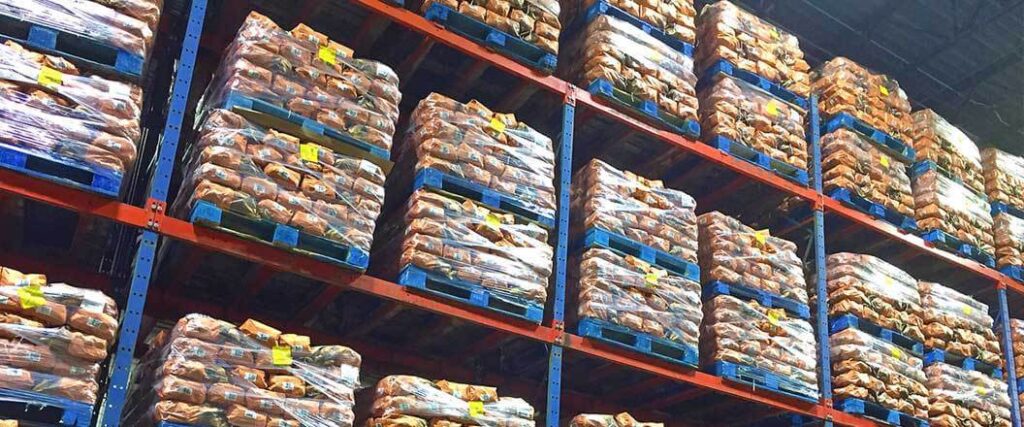
 Copy URL to Clipboard
Copy URL to Clipboard
Flow through distribution is a game-changer when it comes to warehouse operations. Imagine a seamless flow of goods, swiftly moving through a warehouse without any unnecessary stops or delays. This innovative approach optimizes the way orders are fulfilled, offering a host of advantages along the way.
According to mba SKOOL, flow through distribution in warehouses is a highly efficient process. It optimizes order fulfillment and reduces storage time. Goods are received, sorted, and immediately directed to outbound shipping, removing the need for long-term storage. Handling is kept to a minimum, reducing opportunities for damage or errors.
See how you may be able to benefit from flow through distribution to keep your customers happy.
Table of Contents

As mentioned above, flow through distribution moves goods directly from inbound trailers to outbound shipping, without storing them in a warehouse. This saves time and money, and it can also improve customer satisfaction.
Before we go further in-depth about this process, let's take a look at the differences between a warehouse and a distribution center (DC).
These two words may seem like they mean the same thing, but that’s not exactly true. Warehouses may store goods for weeks or months at a time. When orders are placed, items are picked from their storage areas and then packed to await distribution.
Meanwhile, distribution centers (DCs) move products quickly from inbound shipping to outbound distribution. Items might be staged in an outbound shipping area for a day or two, but they are not stored long-term.
The flow through process is best applied via a DC, which is sometimes referred to as a flow through warehouse. This allows cargo to be received, broken down, repackaged, and moved to the next step in distribution with little to no need for storage.
A flow through warehouse enables the seamless movement of goods. Once items are received, they’re sorted, kitted (if necessary), and sent to outbound shipping areas without long-term storage. The goal is to reduce the time products spend in the warehouse while and maximize the speed of order fulfillment.
Flow through warehouses are organized with speed in mind and designed with some of the following traits:
The combination of efficient design and modern technologies allows a flow through warehouse to save time and money when compared to long-term storage. Let’s take a more in-depth look at the advantages offered by a flow through distribution model.

Flow through distribution offers several advantages that can benefit businesses and increase fulfillment optimization in the warehousing and logistics industry.
Some advantages include:
With the advantages of flow through distribution laid out, let’s take a look at how some real-world applications of the process could play out.
These examples show how flow-through distribution can help businesses provide great customer experiences, manage inventory better, and respond to changing market conditions.
Flow through distribution is more efficient than traditional warehousing because it eliminates unnecessary handling steps, which speeds up order processing and reduces errors.
With the rising cost of warehouse operations, minimizing storage time is a vital cost-saving measure. To illustrate, consider the increase in operating costs of warehouses over a five-year period starting in 2017.
| Year Range | Cost in Dollars per Square Foot |
| 2017 | $6.53 |
| 2018-2019 | $7.79 |
| 2020 | $7.81 |
| 2021 | $7.91 |
Source: Statista.com
Multiply these numbers across warehouses that take up thousands of square feet. You’ll see that it amounts to hundreds of thousands in spending.
Warehouse owners have to pass these rising costs off to their customers to make up the difference. Therefore, it makes sense to cut down on warehouse storage whenever possible. Flow through distribution is a great way to accomplish that goal.

You’ve probably run across the term “cross docking” while learning about the flow through process. So, just what is the difference between cross dock and flow through? When considering warehouse solutions, it's essential to understand the differences between these two methods.
While both aim to enhance efficiency and reduce handling, they have distinct characteristics. Understanding the subtle differences between the two methods will help you choose the best distribution model for your needs.
Flow through distribution is ideal for businesses with high-volume, fast-moving goods, and a need for some storage capabilities.
This includes goods that need to be received, broken down, and repackaged as kits, such as:
On the other hand, cross docking is more suitable for immediate transfer of goods from inbound shipments to outbound vehicles without any storage. Pallets may be broken down and reorganized, but not at the SKU level, as found with a flow through distribution model. Cross docking is a great choice for distributing large shipments such as LTL freight orders.
Assessing your specific requirements, product characteristics, and order patterns will help determine which approach aligns best with your business needs. Whichever method you choose, our experienced team of logistics experts can help you take the next step in meeting your distribution goals.
When it comes to optimizing your warehousing and fulfillment operations with flow through distribution, partnering with a reliable logistics provider is essential. Fulfillment and Distribution understands the intricacies of flow through distribution, and offers comprehensive services tailored to meet your needs. These include:
With our expertise in efficient warehouse management and order fulfillment, we can help you streamline operations, boost efficiency, and deliver orders with speed and accuracy. Contact us at 8669893082 or complete a risk-free quote request and experience the benefits of optimized logistics that drive your business forward.
